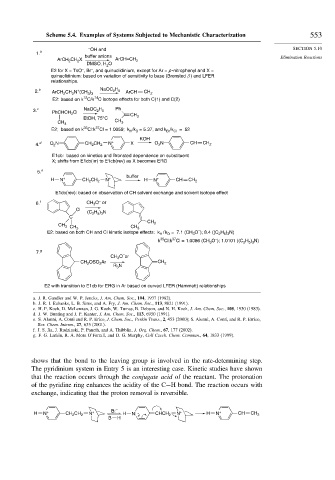Page 572 - Advanced Organic Chemistry Part A - Structure and Mechanisms, 5th ed (2007) - Carey _ Sundberg
P. 572
Scheme 5.4. Examples of Systems Subjected to Mechanistic Characterization 553
– OH and SECTION 5.10
1. a
buffer anions Elimination Reactions
CH X ArCH=CH
ArCH 2 2
2
DMSO, H O
2
–
–
E2 for X = TsO , Br , and quinuclidinium, except for Ar = p -nitrophenyl and X =
quinuclidinium: based on variation of sensitivity to base (Bronsted β ) and LFER
relationships.
+
2 5
2. b ArCH CH N (CH ) NaOC H ArCH CH 2
2
3 3
2
12
14
E2: based on k C/k C isotope effects for both C(1) and C(2)
3. c NaOC H Ph
2 5
PhCHCH 2 Cl
CH
EtOH, 75°C 2
CH 3 CH 3
37
35
E2; based on k Cl:k Cl = 1.0059; k /k = 5.37, and k /k = 52
H D Br Cl
KOH
4. d O 2 N CH 2 CH 2 N + X O N CH CH 2
2
E1cb: based on kinetics and Bronsted dependence on substituent
X; shifts from E1cb(irr) to E1cb(rev) as X becomes ERG
5. e
buffer
H N + CH 2 CH 2 N + H N + CH CH 2
E1cb(rev): based on observation of CH solvent exchange and solvent isotope effect
–
6. f CH 3 O or
Cl
(C H 5 ) 3 N
2
C
CH 3
CH 3
CH 3 CH 3
–
E2: based on both CH and Cl kinetic isotope effects: k / k = 7.1 (CH 3 O ); 8.4 ((C H 5 ) 3 N)
2
H D
37
–
35
k Cl:k Cl = 1.0086 (CH 3 O ); 1.0101 ((C H 5 ) 3 N)
2
7. g
–
CH 3 O or
CH OSO Ar CH 2
2
2
R 3 N
E2 with transition to E1cb for ERG in Ar based on curved LFER (Hammett) relationships
a. J. R. Gandler and W. P. Jencks, J. Am. Chem. Soc., 104, 1937 (1982).
b. J. R. I. Eubanks, L. B. Sims, and A. Fry, J. Am. Chem. Soc., 113, 8821 (1991).
c. H. F. Koch, D. McLennan, J. G. Koch, W. Tumas, B. Dobson, and N. H. Koch, J. Am. Chem. Soc., 105, 1930 (1983).
d. J. W. Bunting and J. P. Kanter, J. Am. Chem. Soc., 113, 6950 (1991).
e. S. Alunni, A. Conti and R. P. Erico, J. Chem. Soc., Perkin Trans., 2, 453 (2000); S. Alunni, A. Conti, and R. P. Errico,
Res. Chem. Interm., 27, 635 (2001).
f. J. S. Jia, J. Rudzinski, P. Paneth, and A. Thibblin, J. Org. Chem., 67, 177 (2002).
g. F. G. Larkin, R. A. More O’Ferrall, and D. G. Murphy, Coll Czech. Chem. Commun., 64, 1833 (1999).
shows that the bond to the leaving group is involved in the rate-determining step.
The pyridinium system in Entry 5 is an interesting case. Kinetic studies have shown
that the reaction occurs through the conjugate acid of the reactant. The protonation
of the pyridine ring enhances the acidity of the C−H bond. The reaction occurs with
exchange, indicating that the proton removal is reversible.
H N + CH 2 CH 2 N + B: – H N: CHCH 2 N + H N + CH CH 2
B H

